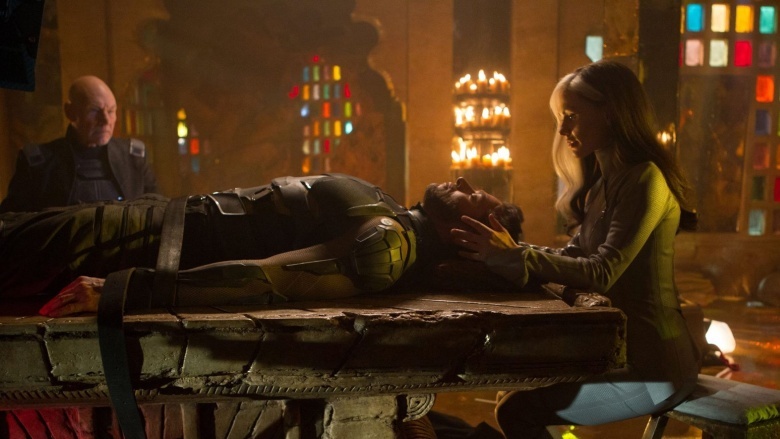Comic Book Movie Endings You Never Knew Existed
While most superhero movies end with some buff, spandex-clad guy saving the day, there are plenty of comic book-based films that haven't ended the way you'd expect. Better yet, some comic films have alternate or unrated endings that were drastically changed, usually in favor of something a little bit more upbeat. We've already brought you a collection of secret Marvel movie endings you never knew about, and here are a few more from all kinds of comics adaptations.
Superman II (1980)
Superman II is regarded by many as the best of Kal-El's movies, but did you know that Richard Donner filmed most of the project before the reins were handed to Richard Lester? Lester's ending is the one we're all familiar with: Superman removes Zod, Non, and Ursa's powers, Lex Luthor returns to prison, Clark Kent wins a fight against a guy who previously beat him up in a diner, Lois Lane gets a Super-kiss that erases her memories of our hero's secret identity, and the Man of Steel puts the American Flag Zod removed back atop the White House.
In Superman II: The Richard Donner Cut, Superman still beats the Kryptonian criminals—and destroys his frozen Fortress of Solitude with his laser vision after the big superpower showdown. After Lois Lane is dropped off at her apartment, she frets that she will never be able to maintain a relationship with Superman/Clark Kent. Instead of hitting her with the amnesic kiss, Superman spins the world back in time. He basically keeps Zod and his cronies from leaving the Phantom Zone, and life for Clark Kent and Lois Lane returns to normal with the superhero's identity now a secret once again. The only problem is that this is yet another time warp ending where Superman goes back to the past to right a wrong, mirroring the first Superman, which saw him reversing time to stop Lois from dying.
Blade: Trinity (2004)
Blade: Trinity may have closed the cinematic story of one of the original R-rated superheroes (along with Dolph Lundgren's Punisher), but director David S. Goyer had some strange ideas for ending the Daywalker trilogy. The third film's theatrical ending features Blade hitting Dracula (called "Drake" in this movie, for some reason) with an arrow filled with a bioweapon that goes on to kill all the vampires in the world. Drake realizes that, despite the bioweapon, Blade will continue his species, since he survived and is still a vampire. The film basically ends with Ryan Reynolds' Hannibal King narrating, telling the audience that Blade is still out in the world somewhere, set on destroying the last remaining vampires. Nothing really special, but it gets the job done, right?
The alternate endings to Blade: Trinity steer the Daywalker in a completely different direction. Goyer's original, unrated ending features Blade being captured by the FBI after his battle with Drake. Just before getting an autopsy, Blade awakens and beats up his guards, corners the nurse assisting the autopsy, and the film ends without letting us know whether he's given into the thirst of vampirism—important since Drake's last words to him were "the Thirst always wins." The book ending for Blade: Trinity, which was filmed as an alternate conclusion for the film's home video extras, features something completely different. The bioweapon used on Drake destroys all the vampires in the world, and Blade finally finishes his longtime quest to kill every last blood-sucker. The vampire-hunting Nightstalker team appears in a new location, squaring off against a new kind of foe. Without any vampires left to fight, what do the Nightstalkers hunt? Werewolves.
X-Men: Days of Future Past (2014)
The seventh X-Men film unravels a lot of the missteps taken by X-Men: The Last Stand while continuing the story of X-Men: First Class. It also helps set the foundation for X-Men: Apocalypse, which steers things back toward the first entry in the franchise. The film ends with Mystique saving the president and preventing a dystopian future in which the Sentinel robots seek to exterminate mutantkind.
An alternate version of Days of Future Past, called The Rogue Cut, restores nearly 17 minutes of previously removed footage. Most of this axed content focuses on Anna Paquin's Rogue trying to help Wolverine time-travel to 1973 in order to stop the Sentinels. Other than Rogue's addition to the future's X-Men team, the most significant deviation from the original cut is Iceman's death, which occurs earlier to allow Magneto and Rogue a chance to escape. We also get a short love scene between Beast and Mystique that leaves us all feeling blue. Another major change is glimpsed during the closing credits. Prior to the post-credits scene showing Apocalypse and his four horsemen, we see Peter Dinklage's Dr. Bolivar Trask incarcerated for his crimes. Surprisingly, he's actually detained in the same prison cell below the Pentagon that was originally used for Magneto.
Men in Black II (2002)
Yup, the Men in Black series is based on a famous comic book, and their second galaxy-saving adventure was meant to end in a completely different way. MiB II concludes with Agents J and K destroying the evil alien monster Serleena. The duo then send the Light of Zartha (played by Rosario Dawson) back home in order to save Earth. In order to erase the New York population's memories of seeing the alien spaceship and giant monster exploding in the sky, MiB activate a giant neuralyzer located in the torch of the Statue of Liberty.
According to Variety, the film's final scenes were supposed to take place at the World Trade Center. One of the towers was said to open up and release a UFO, which was likely meant to carry the Light of Zartha back to its home alien planet—or even a pair of giant neuralyzers, in case they weren't used to launch spaceships.



